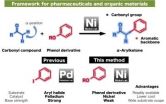(Press-News.org) This news release is available in French.
Montreal, May 27, 2014 — Retail stores overflowing with merchandise can make consumers feel claustrophobic rather than ready to spend. But the recent move towards open, minimally stocked spaces can leave them feeling just as anxious.
The solution to this shopping conundrum may be smell, as new research from Concordia University shows.
In a study recently published in the American Journal of Business, researchers from the university's John Molson School of Business (JMSB) suggest that, when diffused in retail environments, certain scents can reduce the level of anxiety experienced by consumers.
"Our research shows that scents are best at fighting anxiety when they create feelings of openness in crowded retail environments or coziness in minimalist retail spaces," says marketing professor Bianca Grohmann.
Grohmann and her co-author Tina Poon, a graduate of Concordia's Master of Science program in marketing, conducted the study at JMSB's Laboratory for Sensory Research.
To test how scents diffused in the environment affect anxiety levels caused by overly crowded or open spaces, the researchers invited consumers to a lab that was either jam-packed or nearly empty.
In each case, the lab — a simulated retail environment — was infused with one of three ambient scents:
A scent reminiscent of enclosed spaces, like the smell of firewood
A scent evoking open spaces, like the seashore
No scent at all
Consumers evaluated several products, as well as the space in which the experiment was conducted. They then indicated their level of anxiety.
Grohmann and Poon found the following:
In crowded spaces, consumers said they felt least anxious when smelling something that evoked spaciousness.
In an almost empty space, consumers felt much calmer when exposed to an ambient scent evoking closed spaces.
Overall: anxiety levels were highest among consumers in an open space that was infused with a scent related to spaciousness.
"Our study shows that retailers need to carefully consider how they pair shopping space and ambient scent in order to decrease consumers' anxiety levels and improve their shopping experience," Grohmann says.
Ultimately, retailers who contend with small, crowded spaces, either due to limited store size or the volume of merchandise they stock, can prevent feelings of claustrophobia by using space-enhancing scents. However, those following the minimalist trend may want to consider using scents that bring a sense of coziness to the environment.
INFORMATION:
Related links:
Concordia University's John Molson School of Business http://johnmolson.concordia.ca/
John Molson Laboratory for Sensory Research http://johnmolson.concordia.ca/en/faculty-research/research-centres/laboratory-for-sensory-research
MSc programs at JMSB http://johnmolson.concordia.ca/en/graduate-programs/msc-programs
Bianca Grohmann on Explore Concordia http://explore.concordia.ca/bianca-grohmann
Media contact:
Cléa Desjardins
Senior advisor, media relations
University Communications Services
Concordia University
Phone: 514-848-2424, ext. 5068
Email: clea.desjardins@concordia.ca
Web: concordia.ca/now/media-relations
Twitter: twitter.com/CleaDesjardins
Why retailers need to pay attention to the smell of their stores
Ambient scents help calm shoppers, Concordia University study shows
2014-05-27
ELSE PRESS RELEASES FROM THIS DATE:
Imaging scientists develop a better tool for tracking MS
2014-05-27
Imaging scientists at Western University's Robarts Research Institute (London, Canada) have developed a better way to track the progression of Multiple Sclerosis (MS) from its earliest stages. Led by Ravi Menon, PhD, the researchers used what's called "Quantitative Susceptibility (QS) Magnetic Resonance Imaging (MRI)," to measure damage in specific areas of the brain which the study showed to be common to all patients. The findings are published in advance online, in Radiology.
"In MS research, there is something we call a clinical-radiological paradox. When ...
Steroids prescribed in the ICU linked to delirium
2014-05-27
New Johns Hopkins research suggests that critically ill patients receiving steroids in a hospital's intensive care unit (ICU) are significantly more likely to develop delirium. Results of their research, they say, suggest minimizing the use of steroids could reduce delirium in the ICU.
While it usually goes away after a few days, studies show delirium in the ICU has a long-term impact. It has been associated with worse functional recovery and cognitive impairments of a magnitude consistent with moderate traumatic brain injury or mild Alzheimer's disease.
Overall, up ...
HSP90 is a potential target for ameliorating skeletal muscle abnormalities in PD
2014-05-27
Heat shock protein (HSP90) has been suggested to be involved in neuronal protein misfolding and accumulation in Parkinson's disease (PD) brains leading to dopaminergic neuronal death and the eventual dopamine depletion. Therefore, HSP90 has been suggested as a therapeutic target in PD. Dr. Muhammed Al-Jarrah and co-workers from Jordan University of Science and Technology (JUST) point out exercise training significantly inhibited HSP90 overexpression in the soleus and gastrocnemius in PDe rats, which is a potential therapeutic target for ameliorating skeletal muscle abnormalities ...
A new 'Kabuto-like' nickel catalyst forms bioactive frameworks from phenol derivatives
2014-05-27
Researchers at ITbM, Nagoya University developed a new nickel catalyst with a "Kabuto-like" structure that was found to catalyze the cross-coupling reaction between carbonyl compounds and readily available phenol derivatives, to form alpha-arylketones, which are found in many biologically active compounds (Kabuto = a helmet worn by Japanese samurai).
Nagoya, Japan – Professors Kenichiro Itami and Junichiro Yamaguchi of the Institute of Transformative Bio-Molecules (WPI-ITbM) and graduate students Ryosuke Takise and Kei Muto of Nagoya University have succeeded in developing ...
New tick-borne disease threatens primarily immune suppressed persons
2014-05-27
A newly discovered tick-borne bacterium known as "Candidatus Neoehrlichia mikurensis" has been implicated in six cases of disease in Sweden. A new international study led by the Sahlgrenska Academy has shown that this bacterium is primarily a risk for people who are already sick and who are receiving immunosuppressive drugs.
The Candidatus Neoehrlichia mikurensis bacterium, known in the medical world by its short name Neoehrlichia, was discovered and described for the first time in a scientific article in 2010.
The bacterium, which is spread by rodents and ticks mainly ...
New jigsaw piece for the repair of DNA crosslinks
2014-05-27
Environmental influences such as ionizing radiation, intense heat or various chemical substances damage the DNA constantly. Only thanks to efficient repair systems can mutations – changes in the DNA – largely be prevented. DNA crosslinks that covalently link both strands of the DNA double helix are among the most dangerous DNA lesions. Crosslinks block DNA replication and can thus cause cell death. Moreover, their faulty repair can trigger the development of tumors. Crosslink repair is highly complex and only vaguely understood today. A team of cancer researchers headed ...
X-ray dark-field radiography provides detailed imaging of lung diseases
2014-05-27
As the team reports in the Investigative Radiology journal, this method shows promise in detecting diseases such as pulmonary emphysema at an earlier stage, than it is currently available. Conventional radiographic procedures generate images based on the absorption of X-rays as they pass through the tissue. The newly developed technique of X-ray dark-field radiography uses new technology to monitor wave changes during tissue transmission to create higher resolution images.
Detailed images
With the aid of this new technique, the team from the HMGU, KUM and TUM around Dr. ...
Two new possible drug targets for triple negative breast cancer
2014-05-27
HOUSTON -- ( May 27, 2014 ) -- The suppression of two genes reduce breast cancer tumor formation and metastasis by interfering with blood vessel formation and recruitment, report scientists from Houston Methodist and five other institutions in the Proceedings of the National Academy of Sciences (now online). The findings may help medical researchers identify effective drug targets for triple negative breast cancer, or TNBC.
The genes, MLF2 (myeloid leukemia factor 2) and RPL39 (a ribosomal protein), were found to most profoundly impact the production of nitric oxide synthase, ...
Large numbers of shadow economy entrepreneurs in developing countries, according to new report
2014-05-27
There are large numbers of entrepreneurs in developing countries who aren't registering their businesses with official authorities, hampering economic growth, according to new research.
Shadow entrepreneurs are individuals who manage a business that sells legitimate goods and services but they do not register it. This means that they do not pay tax, operating in a shadow economy where business activities are performed outside the reach of government authorities. The shadow economy results in loss of tax revenue, unfair competition to registered businesses and also poor ...
Mycotoxin protects against nematodes
2014-05-27
This news release is available in German. Most terrestrial plants enter into biocoenosis with funghi. Both sides benefit: the fungus, which surrounds the small roots of the host plant with a thick felt, supplies the plant with trace elements and water. The plant, in turn, supplies the fungus with sugars and other metabolites which it is unable to produce itself.
Toxic protein kills intestinal cells
ETH researchers from the research group of microbiology professor Markus Aebi have discovered a protein in the cells of one such ectomycorrhizal fungus which offers an ...
LAST 30 PRESS RELEASES:
What determines the fate of a T cell?
Candida auris: genetic process revealed which could be treatment target for deadly fungal disease
Groundbreaking discovery turns household plastic recycling into anti-cancer medication
Blocking a key inflammatory pathway improves liver structure and vascular function in cirrhosis, study finds
Continuous spread: Raccoon roundworm detected in nine European countries
HKUST Engineering researchers developed a novel photodetector to enhance the performance of on-chip light monitoring
Strategic river sensors could have forewarned of Texas Camp flood disaster
Drone sampling of whale breath reveals first evidence of potentially deadly virus in Arctic
Roman soldiers defending Hadrian’s Wall infected by parasites, study finds
Pinochet’s prisoners were tormented with music but still found solace in it, a new book reveals
Fertility remains high in rural Tanzania despite access to family planning
AI-assisted device can improve autism care access
Kinetic careers
Uncovering how parasitic plants avoid attacking themselves to improve crop resistance
Nanoparticle vaccine strategy could protect against Ebola and other deadly filoviruses
Study finds brain care score can predict risk of stroke across racial groups
Key lung immune cells can intensify allergic reactions
Do hormones explain why women experience more gut pain?
New materials conduct ions in solids as easily as in liquids
Breakthrough of the Year: Renewable energy begins to eclipse fossil fuel-based sources
LLM use is reshaping scientific enterprise by increasing output, reducing quality and more
Introducing LightGen, a chip for ultra-fast, ultra-efficient generative AI
Astronomers see fireworks from violent collisions around nearby star
ACC/AHA issue new guideline on managing congenital heart disease in adults
Cosmic crash caught on camera
Is talented youth nurtured the wrong way? New study shows: top performers develop differently than assumed
Ants: An untapped resource in the development of antibiotics?
Archaeologists use AI to create prehistoric video game
Mitochondria migrate toward the cell membrane in response to high glucose levels
Tiny viral switch offers hope against drug-resistant bacteria
[Press-News.org] Why retailers need to pay attention to the smell of their storesAmbient scents help calm shoppers, Concordia University study shows


